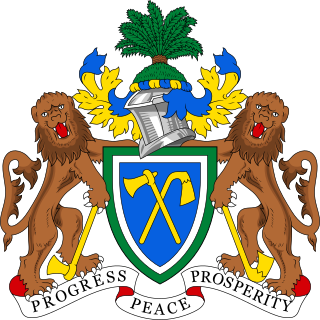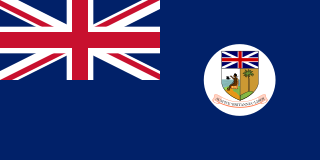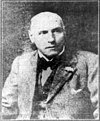
Governor-general, or governor general, is the title of an office-holder. In the context of governors-general and former British colonies, governors-general are appointed as viceroy to represent the monarch of a personal union in any sovereign state over which the monarch does not normally reign in person. Governors-general have also previously been appointed in respect of major colonial states or other territories held by either a monarchy or republic, such as Japan in Korea and Taiwan and France in Indochina.
High commissioner is the title of various high-ranking, special executive positions held by a commission of appointment.
A resident minister, or resident for short, is a government official required to take up permanent residence in another country. A representative of his government, he officially has diplomatic functions which are often seen as a form of indirect rule.
In the British Empire, a self-governing colony was a colony with an elected government in which elected rulers were able to make most decisions without referring to the colonial power with nominal control of the colony. This was in contrast to a Crown colony, in which the British Government ruled and legislated via an appointed Governor, with or without the assistance of an appointed Council. Most self-governing colonies had responsible government.

Southern Nigeria was a British protectorate in the coastal areas of modern-day Nigeria formed in 1900 from the union of the Niger Coast Protectorate with territories chartered by the Royal Niger Company below Lokoja on the Niger River.

Aden Colony was a crown colony of the United Kingdom from 1937 to 1963 located in the southern part of modern-day Yemen. It consisted of the port city of Aden and also included the outlying islands of Kamaran, Perim and the Khuria Muria archipelago with a total area of 192 km2 (74 sq mi). Initially a key port for the British East India Company, it was annexed by the British in 1839 to secure maritime routes and prevent piracy in the Arabian Sea. Its strategic position at the entrance to the Red Sea made it a vital stopover for ships traveling between Europe, India, and the Far East, especially after the opening of the Suez Canal in 1869. Aden quickly became a major coaling station and transit hub for British shipping, and its significance to the British Empire grew throughout the 19th and early 20th centuries.

Colonial Nigeria was ruled by the British Empire from the mid-nineteenth century until 1st of October 1960 when Nigeria achieved independence. Britain annexed Lagos in 1861 and established the Oil River Protectorate in 1884. British influence in the Niger area increased gradually over the 19th century, but Britain did not effectively occupy the area until 1885. Other European powers acknowledged Britain's dominance over the area in the 1885 Berlin Conference.

In the Commonwealth of Nations, a high commissioner is the senior diplomat, generally ranking as an ambassador, in charge of the diplomatic mission of one Commonwealth government to another. Instead of an embassy, the diplomatic mission is generally called a high commission.

The Colony and Protectorate of Kenya, commonly known as British Kenya or British East Africa, was part of the British Empire in Africa from 1920 until 1963. It was established when the former East Africa Protectorate was transformed into a British Crown colony in 1920. Technically, the "Colony of Kenya" referred to the interior lands, while a 16 km (10 mi) coastal strip, nominally on lease from the Sultan of Zanzibar, was the "Protectorate of Kenya", but the two were controlled as a single administrative unit. The colony came to an end in 1963 when a native Kenyan majority government was elected for the first time and eventually declared independence.
There are six monarchies in Oceania with an individual hereditary monarch, who is recognised as the head of state. Each is a constitutional monarchy: the sovereign inherits his or her office, usually keeps it until death or abdication, but is bound by laws and customs in the exercise of their powers. Five of these independent states share King Charles III as their head of state, making them part of a global grouping known as the Commonwealth realms; in addition, all monarchies of Oceania are members of the Commonwealth of Nations. The only sovereign monarchy in Oceania that does not share a monarch with another state is Tonga. Australia and New Zealand have dependencies within the region and outside it, although five non-sovereign constituent monarchs are recognized by New Zealand, Papua New Guinea and France.
The decolonisation of Asia was the gradual growth of independence movements in Asia, leading ultimately to the retreat of foreign powers and the creation of several nation-states in the region.

The Federation of Nigeria was a predecessor to modern-day Nigeria from 1954 to 1963. It was a British protectorate until its independence on 1 October 1960.

Uganda became an independent sovereign state on 9 October 1962. As a Commonwealth realm, the British monarch, Elizabeth II, remained head of state as Queen of Uganda until the link with the British monarchy was severed on 9 October 1963 and the Kabaka (King) of Buganda, Sir Edward Mutesa II, became the first President of Uganda.
British protectorates were protectorates under the jurisdiction of the British government. Many territories which became British protectorates already had local rulers with whom the Crown negotiated through treaty, acknowledging their status whilst simultaneously offering protection. British protectorates were therefore governed by indirect rule. In most cases, the local ruler, as well as the subjects of the ruler, were not British subjects. British protected states represented a more loose form of British suzerainty, where the local rulers retained absolute control over the states' internal affairs and the British exercised control over defence and foreign affairs.

From 1960 to 1963, Nigeria was a sovereign state and an independent constitutional monarchy. Nigeria shared the monarch with Australia, Canada, United Kingdom, and certain other sovereign states. The monarch's constitutional roles were mostly delegated to the governor-general of Nigeria.

Elizabeth II was Queen of The Gambia from 1965 to 1970, when the Gambia was an independent sovereign state and a constitutional monarchy within the Commonwealth of Nations. She was also the monarch of the other Commonwealth realms, including the United Kingdom. Her constitutional roles in the Gambia were delegated to the governor-general.

Elizabeth II was Queen of Kenya from 1963 to 1964, when Kenya was an independent sovereign state with a constitutional monarchy. She was also the sovereign of the other Commonwealth realms, including the United Kingdom. Her roles as the Kenyan head of state were delegated to the governor-general of Kenya.

Elizabeth II was Queen of Uganda as well as the head of state of Uganda from 1962 to 1963, when the country was an independent constitutional monarchy. She was also the sovereign of other countries in the Commonwealth of Nations, including the United Kingdom.

The Colony and Protectorate of Sierra Leone was the British colonial administration in Sierra Leone from 1808 to 1961, part of the British Empire from the abolitionism era until the decolonisation era. The Crown colony, which included the area surrounding Freetown, was established in 1808. The protectorate was established in 1896 and included the interior of what is today known as Sierra Leone.

























